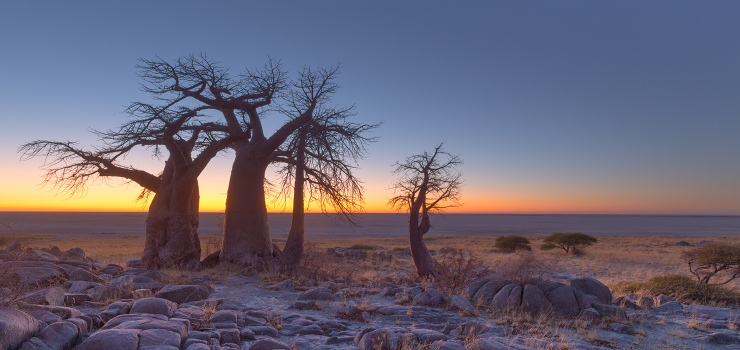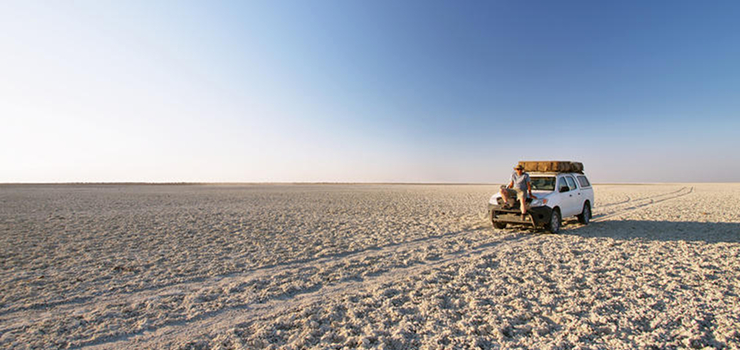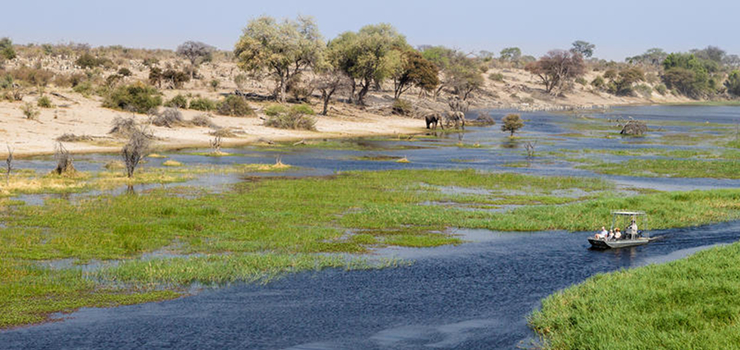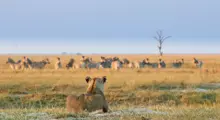Situated between Maun and Francistown, just north-east of Botswana’s Central Kalahari Game Reserve lies one of the country’s most spectacular natural phenomena - The Makgadikgadi Pans. Covering an area of over 30 000 km² these Pans are the largest salt flats in the world that contain various habitats within them. Rather than being one single pan, the Makgadikgadi Pans are made up of many adjoining pans with desert sand running between them. The three largest pans are the Ntwetwe, Sua and Nxai which teem with natural beauty and fascinating wildlife.

As remnants of Lake Makgadikgadi which dried up thousands of years ago, the Pan’s white-baked topography comprises of many threatened plant species, including the Baobab and Hoodia Trees. The Boteti River forms the western boundary of the Makgadikgadi Pans National Park, luring many thirsty animals to the area. The river’s main attraction is the annual zebra migration. During the dry winter season (April -October), the lack of water over the pans takes thousands of Burchell zebra and blue wildebeest towards the banks of the Boteti River. Here food and water are richly available. The migration makes its way back to the clay pans during the wet summer season (November- March) as they begin to fill up with rain water. With the steady increase of rainfall, the pans turn into a marshy oasis creating an important breeding ground for the greater and lesser Flamingo. These majestic birds flock to the Pans during the wet season to mate and lay their eggs in unique conical nests made from clay.

The fluctuation of seasons in the Makgadikgadi area drastically alters the landscape making it a remarkable destination to visit any time of the year. Winter sees warm pleasant daytime temperatures that sit around 26°C/79°F, while evenings cool down to an average of 7°C/45°F.
Hot days are extremely common during the summer months. Here temperatures sit between 17°C/63°F and 34°C/93°F with afternoon downpours regularly bringing cool relief. As the Pans turn into a vast but shallow shimmering lake, plants begin to bloom while bird and animal populations flourish. This does, however, make driving difficult as the wet, muddy roads become slippery - more reason to witness the pans from above on a scenic helicopter flight. The wet season is also ideal for bird enthusiasts, when other resident and migrant birds, namely the great white pelican, the saddle-billed stork, and the red-necked falcon prepare for the breeding season.

Along with the abundance of wildlife, visitors are spoiled by choice at the range of accommodation types in and around the Makgadikgadi Pans. From charming tented bush-camps in the middle of the Kalahari to rustic river cottages and exclusive safari lodges.
When it comes to activities and attractions, the dry season is the perfect time to head out on interactive bush walks with the region’s aboriginal people, the San Bushmen. Here you will spend time learning about the Bushman culture and way of life whilst gaining access to some of their best survival tactics for living in such a harsh environment. Also on offer, quad-biking safaris that exhibit all the features of classic safari, but with a thrilling sense of adventure. Not only do you get to experience the landscape’s shimmering white crust for what it truly is but riding for hours on end with nowhere in particular to go, is a soul-searching experience.

